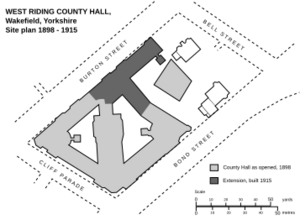County Hall, Wakefield facts for kids
Quick facts for kids County Hall |
|
|---|---|
 |
|
| Location | Wakefield, West Yorkshire |
| Built | 1898 |
| Architect | James S Gibson |
| Architectural style(s) | Gothic style |
|
Listed Building – Grade I
|
|
| Designated | 30 March 1971 |
| Reference no. | 1242349 |
| Lua error in Module:Location_map at line 420: attempt to index field 'wikibase' (a nil value). | |
County Hall, also known as West Riding County Hall, is an important building in Wakefield, West Yorkshire, England. You can find it where Bond Street and Cliff Parade meet. This grand building is the main office for the Wakefield Metropolitan District Council. This council helps run the local area.
County Hall is a Grade I listed building. This means it's a very special historic building. It is protected because of its unique architecture and history.
Contents
Building a New Home for the Council
In 1888, a new law called the Local Government Act 1888 was passed. This law created county councils in every county. These councils needed places to meet and work. The West Riding of Yorkshire County Council needed a permanent home.
Their first meeting was in February 1889. It took place in Wakefield Town Hall. The council then had to choose a permanent location. The choice was between Leeds and Wakefield. After much discussion, Wakefield was chosen in 1892.
The chosen spot for the new County Hall was where Rishworth House stood. This was a large house built in 1812. The County Council used Rishworth House for meetings and offices.
Designing County Hall
To design the new building, the County Council held a competition. Architects submitted their ideas for the new hall. The council suggested a "Queen Anne" or "Renaissance" style. These styles were popular for old towns like Wakefield.
However, the winning design was by James Glen Sivewright Gibson. He chose a Gothic style instead. This style is known for its pointed arches and detailed stonework. Gibson designed the main meeting room, called the Council Chamber, to be on an upper floor. This helped keep it quiet from street noise.
The inside of County Hall is also very special. Much of the decoration was designed by Henry Charles Fehr. You can see many symbolic figures and images. For example, on the main staircase, an owl and scales represent thinking and justice. There are also figures showing debate and dictation.
Other decorations show the main industries of the West Riding area. These are often surrounded by the White Rose of York. You might also spot symbols for wisdom, independence, honesty, and hard work. There are also figures representing peace and plenty. These show a winged figure with an olive tree and another with fruit and grain.
Building and Expanding the Hall
The company that built County Hall was Messrs. Armitage and Hodgson from Leeds. The building took four years to complete. It was finished in 1898. The Marquess of Ripon officially opened it on February 22, 1898.
Later, between 1912 and 1915, new parts were added to the building. These additions were designed by George Crook of Wakefield. He made sure the new parts matched Gibson's original Gothic style.
County Hall became a model for other buildings. In 1913, a group from Middlesex County Council visited Wakefield. They liked the Council Chamber so much that they decided to copy it. They used the design for their own building, the Middlesex Guildhall.
Even royalty has visited County Hall! In 1949, Princess Elizabeth (who later became Queen Elizabeth II) visited the hall. She was with the Duke of Edinburgh.
County Hall Today
In 1974, a new council was formed called the West Yorkshire Metropolitan County Council. This council took over County Hall and used it as its main office. However, this council was later closed down in 1986.
In December 1987, the City of Wakefield Metropolitan District Council bought the building. They spent over £3 million to fix it up and make it modern. In February 1991, a plaque was put up to celebrate the building's new ownership and its refurbishment. Today, County Hall continues to serve as an important center for local government in Wakefield.
Images for kids




